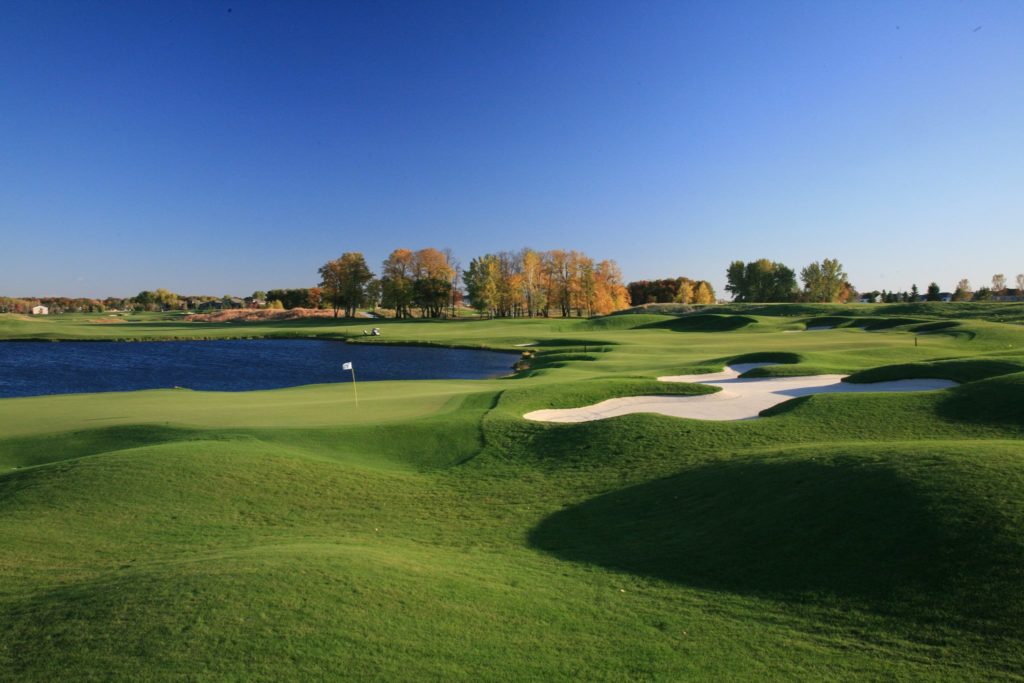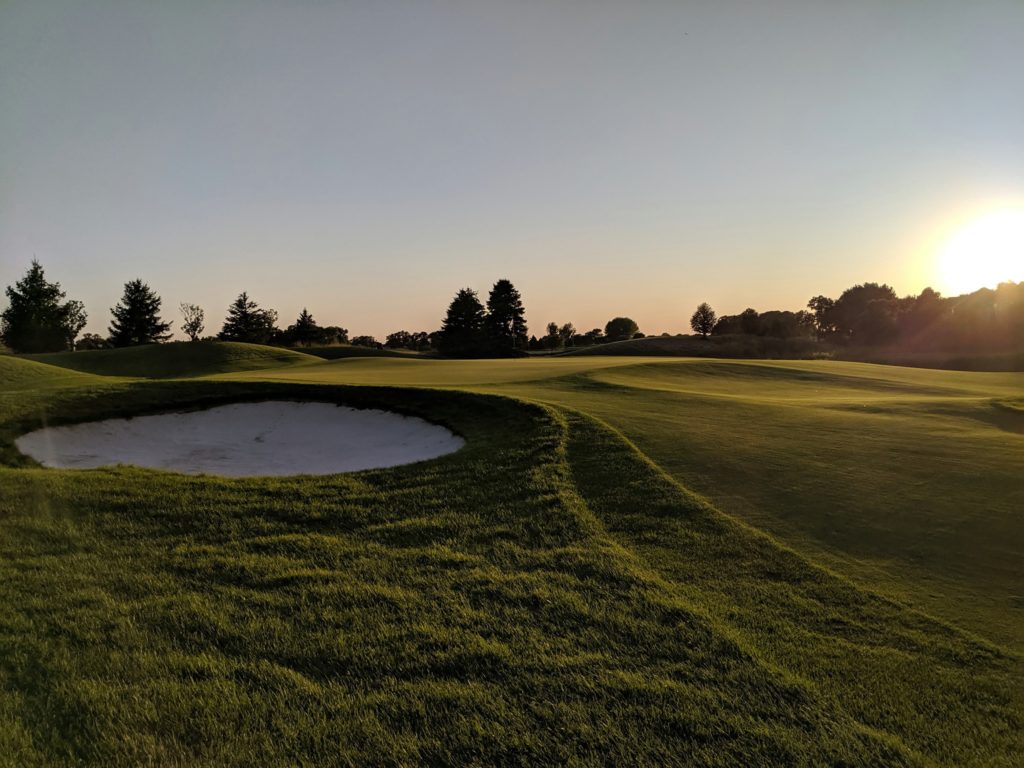
TPC Twin Cities, which will host the 3M Open for fourth time when the PGA Tour heads to Blaine, Minnesota on July 21-24, is a study in contrasts – and that’s a good thing.
It’s an example of the differences in the challenges for the everyday, recreational golfer as compared to the touring pro – a facility that does all the right things to keep its membership happy 51 weeks of the year and the Tour on its toes for its annual visit to the Minneapolis/St. Paul area.
TPC Twin Cities, an Arnold Palmer design that was opened in 2001 about 15 minutes north of Minnesota’s largest metropolis, was the home of 3M Championship on the PGA Tour Champions calendar for 18 seasons. Designed specifically by Palmer for the older Tour players and the everyday golfer, the course (which was built on the site of an old sod farm) had plenty of wide fairways and was considered easy for even the senior Tour players.

TPC Twin Cities
The attraction
The PGA Tour’s younger, stronger and longer-off-the-tee players came calling after the senior set’s final visit, prompting tweaks and additions to the course that make it a test for the best golfers in the world while keeping it playable for the rest of us.
Making such changes on an already special course can be a fine line, and local golf observers were skeptical that TPC Twin Cities and its open spaces of Blaine would provide a valid shot-making challenge for the PGA Tour’s collection of stars.
But with the help of Palmer’s design team, former U.S. Open champion Tom Lehman (a Minnesota native), and Steve Wenzlaff of the PGA Tour, TPC Twin Cities has made the transition. The fact that both Lehman and Wenzlaff had been advisers to Palmer and his team in the late 1990s when the property’s routing was first under the blade helped in the process.
Holes were lengthened, trees were planted, hazards were brought closer to the landing areas off the tees and around the greens complexes, and fairways were narrowed, the latter more prominent via selective mowing patterns when the Tour is in town. The competitive enhancement project has allowed the course to produce a real test for the Tour’s players over the past three years.
The course
TPC Twin Cities’ routing, which plays as a par-72 and 7,513 yards from the back tees for the membership, is framed by stands of grand oak, spruce, and pine trees as it flows up and down the mostly open prairie and hilly terrain of the Minnesota countryside.
Native prairie grasses line the fairways, and the layout sports a handful of creeks and several significant ponds, including one that is almost a lake over which the approach at the 596-yard par-5 18th hole is attacked.
The pros will play TPC Twin Cities as a par-71, with the 546-yard par-5 third changed to a tough, uphill 495-yard two-shotter for the tournament.
One of the best holes here is the 381-yard seventh, a reachable par 4 for the Tour players if they can carry the lake at the front of the green and Palmer’s signature beach bunker that protect the putting surface. It’s a true risk/reward hole and will force a decision; those that choose to lay up will likely have an approach shot of less than 100 yards.
Many of the changes made in 2018 and since affected TPC Twin Cities’ finishing stretch.
On the 411-yard par-4 16th hole, rough was replaced with bent grass, and bunkers were moved to tighten the hole. The par-3 17th hole received new tee boxes to lengthen the test to 229 yards. The lake on the par-5 18th hole was doubled in size, completely changing how players have to approach it, and making it a true three-shot hole for even the long-hitting pros.
TPC Twin Cities is not an easy golf course, even for the best golfers Players have to lay up in some spots to avoid where the bunkers pinch in. It has a unique character and strategic diversity, with multiple tees on each hole allowing golfers of all abilities to enjoy its subtle nuances and intricate design features.
For the everyday golfer and the low-handicapper, TPC Twin Cities – which is part of the TPC Network’s 30 courses – allows a chance to play where the pros play, where flawless conditions abound and where service exceeds expectations.

Other choices in the Twin Cities
While you might not be able to wrangle a round at TPC Twin Cites without the invite of a member, there are plenty of great municipal and public access courses in the Minneapolis/St. Paul area. Here are four to consider:
Chaska Town Course (Chaska)
Designed by the late Arthur Hills, Chaska Town Course is rated as one of the best in Minnesota. Laid out over 285 acres a half-hour south of Minneapolis through oak groves, open prairie, and marshlands, the course is grassed with lush bent grass in all playing areas. The course is owned and operated by the city of Chaska but is much more a run-of-the-mill municipal facility; it’s good enough to have hosted the 2006 U.S. Amateur (along with Hazeltine National, which is just three miles up the road). The two courses will again combine to host the U.S. Amateur in 2024.
Rush Creek Golf Club (Maple Grove)
The experience at Rush Creek Golf Club is like teeing it up at a private golf club at public course prices. Opened in 1996 and designed by the late, great Bob Cupp in collaboration with U.S. Amateur champ John Fought, the golf course is just 20 miles from downtown Minneapolis. It has six sets of tee boxes and can be stretched to more than 7,200 yards from the Duncan tees. Rush Creek has hosted LPGA events, the 2004 U.S. Amateur Public Links Championship and was the site of the 2021 Minnesota Golf Association Amateur Championship. One of the other cool things here is the popular Mac Nine short course, a 640-yard family-friendly track that’s fun, fun, fun.
StoneRidge Golf Club (Stillwater)
Ranked by Golfweek magazine as the No. 1 public access golf course in the Twin Cities, a round at StoneRidge Golf Club is a unique experience. The course was designed by Bobby Weed and opened for play in 2000 and is located 15 minutes east of St. Paul on the site of a reclaimed sand quarry. The links-style layout, the native fescue grasses swaying in the wind, the pot bunkers, and large greens all combine to give golfers that “across the pond” feeling. The size of the putting surfaces and multiple tee settings make every round here a different experience with new challenges.
Willingers Golf Club (Northfield)
Set about 30 miles south of Minneapolis, Willingers Golf Club is routed on a 275-acre plot by Gil Miller. It plays through a 40-acre forest and sports 60 acres of naturally open water, marshes, and wetlands. The 6,809-yard course features significant elevation and topography changes, blending the many natural elements of the land. Fifty-five sand bunkers are placed throughout for aesthetics and strategic value while large greens, pristine landing areas and exacting approach shots have led Willingers to be listed highly among the area’s course rankings.

